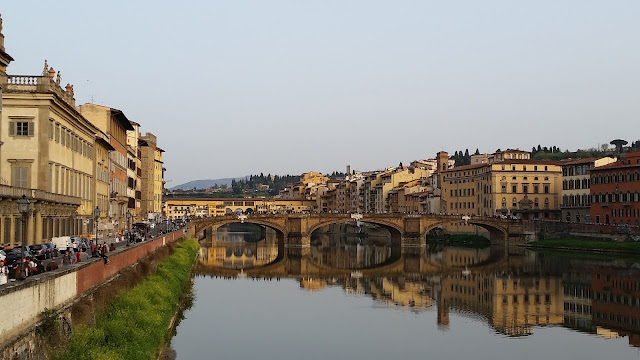Florence
I
use the phrase ‘reverse nostalgia’ to describe the feeling akin to wanderlust.
More so than just the urge to travel however, I aim to capture the slightly
melancholic tinge of the emotion. A subconscious but lingering urge to be
somewhere far away, different, exotic; where no one knows who I am, where I can
eavesdrop on conversations without understanding anything except an odd phrase,
but to still be able to enjoy the phonetic cadences of a foreign tongue and to
reflect that life, though under a different sky, still vibrate to the same
harmony of human emotions.
But
I realised, after stepping onto the cobbled streets of Florence once again that
the phrase doesn’t quite hold. Having been here twice before, I realised even
when I was embarking on the last of my many long and arduous flights that the
joyous exuberance welling up inside is the anticipation of nostalgia fulfilled.
Florence,
with her mixture of antiquity and decay, imparted upon me her incredible
vitality once again. The multi-tiered assault on the senses alone was enough to
dispel the thick fog of jetlag. The cacophony of noises, the magnificently and
quietly enclosed alleys, the Duomo in its Romanesque splendour, all
satisfyingly familiar and refreshingly solid. But, like nostalgia, it is the
things forgotten that, when regained, when that bit of missing memory is found
on the bottom of a dusty drawer in one’s mind, give one the cathartic feeling
of anagnorisis. In my case it is the aromas. A
distinctive mixture of everything putrid and fragrant that surprisingly forms a bouquet redolent
with life.
Though
the visit was short, I intended it to be sharp. One thing I missed on my
previous two visits was the Galleria dell’Accademia, where Michelangelo’s David
resides. Though various replicas of the David strides around the city,
including one outside the Palazzo della Signoria, where the original once
stood, the original five-metre marble form that took Michelangelo, who was only
26 years old at its inception, more than three years to complete, is a sight to
behold. Vasari, the notable art historian, wrote of the David that ‘once you
have seen it, you don’t have to see any other sculptures.’ Most art historians
agree that David is depicted before his battle with Goliath. From the drawn
eyebrows, the intense gaze and the tension as well as the contrapposto pose
pregnant with the notion of alacrity, the quiet marble exclaims youth, vigour
and resolution.
I
took a walk to the river Arno in a golden afternoon on my way to find the
Galileo museum. The medieval bridge is still tenanted by shops, selling
souvenirs and jewellery to tourists that funnel into the bridge. The bronze
bust of Cellini, the goldsmith and sculpture, stands in the middle of Ponte
Vecchio. The heavy laden bridge also carries on top of it Vasari’s corridor, an
enclosed passageway which links the Palazzo Pitti to Palazzo Vecchio by the
order of Cosimo de’Medici, who wished to travel freely between the residential
palace and the government offices without fear.
The
Galileo museum is situated just adjacent to the Uffizi gallery; its entrance
comparably modest but is marked by a modern sundial. The museum was renamed the
Galileo museum only in 2010, four centuries after the publication of Galileo’s
Sidereus Nuncius or the Starry Messenger, in which, through his observations
with telescopes, Galileo opened the door to a new wave of scientific
renaissance. The museum contains a fascinating display of scientific equipment
throughout the ages, dating from as early as the 15th century. Many
of these instruments surprising in their ingenuity and workmanship, combining
function and form wonderfully and are often used by the nobility as
show-pieces, much like the latest smart-phones. Theses includes a huge
armillary sphere or a spherical orrery, made by Santucci, a beautifully
elaborate object of engineering masterpiece. There are also quaint examples of
visual illusions such as two-way pictures and exquisite ladies’ microscopes. The
pièce-de-résistance however are two telescopes made by Galileo himself, through
which he made his ground-shaking observations of the heavens, as well as,
somewhat strangely, the relics of the man himself in the form of a preserved
finger bone and a tooth. For those of us who, as it were, worship at the altar
of science, these are as close as holy objects as could be. But it struck me,
as I gazed upon the sinewy remains of the great astronomer encased in an
elaborately ornate glass case, somewhat kitsch.
Emerging
from the museum into the dazzling Tuscan sun, hearing the tolling of the cathedral
bells reverberating in the cerulean sky as I walked in the uneven cobble-stoned
alleys where Leonardo, Michelangelo, Raphael, Botticelli, Dante and Galileo meandered,
I can’t but smile as I remember Verdi’s saying “You can have the universe if I
can have Italy.”







Comments
Post a Comment